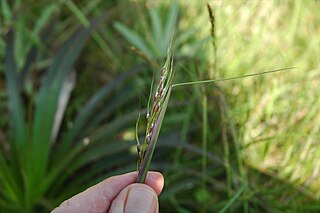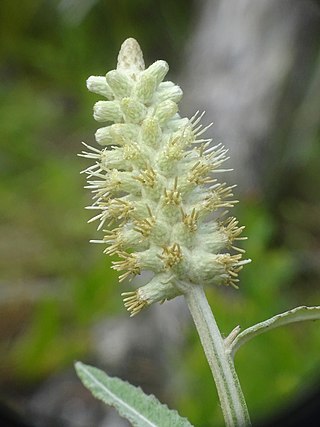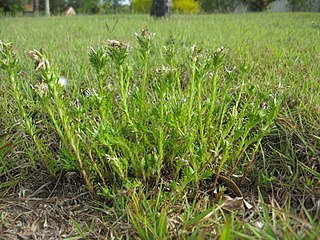
Schinus is a genus of flowering trees and tall shrubs in the sumac family, Anacardiaceae. Members of the genus are commonly known as pepper trees. The Peruvian pepper tree is the source of the spice known as pink peppercorn.

Porophyllum is a genus of flowering plants in the tribe Tageteae within the family Asteraceae known commonly as the poreleaf genus.

Grindelia (gumweed) is a genus of plants native to the Americas belonging to the family Asteraceae. The genus was named for Latvian botanist David Hieronymus Grindel, 1776–1836.

Trixis is a genus of shrubs in the family Asteraceae, native to North and South America including the West Indies.

Soliva is a genus of South American plants in the sunflower family. Burrweed is a common name for some species in this genus.

Zephyranthes candida, with common names that include autumn zephyrlily, white windflower, white rain lily, and Peruvian swamp lily, is a species of rain lily native to South America including Argentina, Uruguay, Paraguay, and Brazil. The species is widely cultivated as an ornamental and reportedly naturalized in many places.

Bothriochloa is a common and widespread genus of plants in the grass family native to many countries on all inhabited continents and many islands. They are often called beardgrass, bluegrass or bluestem. Some species are invasive in areas where they have been introduced.

Citronella aka Andreea is a genus of trees and shrubs in the family Cardiopteridaceae described as a genus in 1832. It is native to tropical regions of South and Central America, insular Southeast Asia, Australia, and islands of the western Pacific. The genus was formerly treated as belonging to the family Icacinaceae.

Heliotropium curassavicum, commonly called salt heliotrope, a species of flowering plant in the borage family (Boraginaceae). It is native to much of the Americas, from Canada to Argentina, including the West Indies and Hawaii. It can be found as an introduced, and sometimes invasive, species in Africa, Asia, Australia, and Europe. It thrives in salty soils, such as beach sand, alkali flats, and salt marshes. It is often found in disturbed coastal sites.

Piptochaetium, or speargrass, is a genus of plants in the grass family, native to North and South America. Piptochaetium is a bunchgrass genus in the tribe Stipeae.
Luziola (watergrass) is a genus of New World in the grass family, native to North and South America including the West Indies.

Schizachyrium is a widespread genus of plants in the grass family. The name is derived from the Ancient Greek words σχίζειν, meaning "to split," and ἄχυρον, meaning "chaff." It refers to either the glume or the toothed lemmas.

Tessaria is a genus of South American plants in the tribe Inuleae within the family Asteraceae.

Sphagneticola is a genus of flowering plants in the family Asteraceae. Creeping-oxeye is a common name for plants in this genus.

Pavonia hastata, commonly known as spearleaf swampmallow or pink pavonia, is a shrub in the family Malvaceae. The species is native to Brazil, Bolivia, Argentina, Paraguay and Uruguay. It was previously considered to be native to Australia as well, but is no longer thought to be.

Gamochaeta is a genus of flowering plants in the family Asteraceae. There has not always been agreement among botanists regarding its status as a recognized genus, but it has become more accepted in recent years. It currently includes many plants that previously belonged in genus Gnaphalium. Like many species of Gnaphalium, many Gamochaeta are called cudweeds or everlastings.

Pterocaulon pycnostachyum, with the common names dense-spike blackroot, fox-tail blackroot or coastal blackroot, is a plant species native to Alabama, Mississippi, North Carolina, Florida, Georgia, and South Carolina. It can be found in pinelands, ditches, depressions, and fields.

Spermacoce alata, the winged false buttonweed, is a species of plant in the Rubiaceae. It is widespread across the warmer parts of the Western Hemisphere and naturalized in many other parts of the world.

Facelis retusa, the annual trampweed, is a South American species flowering plants in the family Asteraceae. It is native Brazil, Bolivia, Paraguay, Uruguay, northern Argentina, Chile; naturalized in parts of Africa, Australia, and North America including the southeastern and south-central United States, and considered as a noxious weed in some of those places.
Hypochaeris microcephala, the smallhead cat's ear, is a species of plants in the tribe Cichorieae within the family Asteraceae. It is native to South America and naturalized in parts of North America.


















